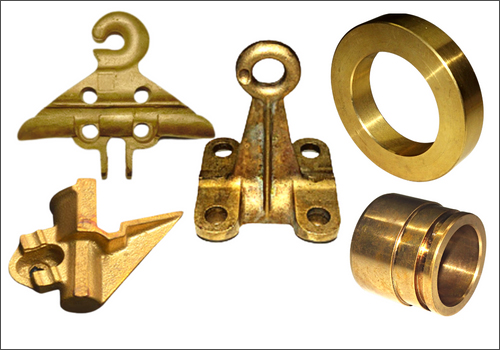Non-Ferrous Casting: Manufacturer, Supplier.
Non-ferrous alloys do not contain iron in appreciable amounts.
Metals like Copper, Ph.bronze, Alu.bronze, Mg.bronze, Gunmetal, Brass, Aluminium, Zinc, Lead and Titanium
Non-ferrous castings can be made using sand casting process, shell moulding process, investment casting process etc.
Materials
We use following material for Non Ferrous Casting
Copper
Phosphor Bronze
Manganese Bronze
Gun Metal / Brass
Aluminium
Lead
Zinc Alloy
Indo German Shell Cast is a leading manufacturer of ferrous and non-ferrous castings, specializing in Copper Casting, Gun Metal Casting, Bronze Casting, Phosphor Bronze Casting and Metal Alloys . With a strong presence in both domestic and international markets, we cater to diverse industries such as pharmaceutical industries, railway systems, cement industries and others ensuring excellence through a wide client base. As a customer-centric organization, our goal is to expand our reach by delivering unparalleled customer satisfaction. We offer comprehensive casting and machining solutions, equipped with modern facilities to meet high quality standards.
Process:
Non-ferrous casting involves the process of shaping metals that do not contain significant amounts of iron. This category includes a variety of materials such as aluminum,copper, zinc, lead,phosphor bronze, aluminium bronze,manganese bronze and gun metal/brass, each possessing unique properties that make them suitable for specific applications. The casting process for non-ferrous metals typically includes techniques like sand casting, die casting and investment casting, allowing for elaborate designs and high-quality finishes.
Aluminum is one of the most commonly used non-ferrous metals due to its lightweight and rust proof nature, making it ideal for various components.Copper, known for its excellent electrical and thermal conductivity, is often used in electrical applications and plumbing fixtures.Phosphor bronze and aluminium bronze are favored in applications requiring high strength and corrosion resistance, particularly in marine environments. Manganese bronze is utilized for its toughness and wear resistance in components exposed to high stress, while gun metal/brass is commonly used for fittings and valves due to its durability. Zinc alloy casting, often used for die-casting applications, provides resilience and is widely applied in various consumer products. The properties of non-ferrous metals allows for a range of surface treatments, enhancing their performance in harsh environments.
The demand for non-ferrous castings has been increasing due to their application in innovative technologies. Non-ferrous casting foundries often invest in advanced technologies and techniques to meet the evolving needs of the market, ensuring high precision and quality in their products.
Benefits:
- Low-weight Structures: Non-ferrous castings such as aluminum and magnesium, allow for the creation of lightweight components which is essential in engineering applications where reducing weight can enhance performance and fuel efficiency.
- Rust Proof: Many non-ferrous metals exhibit superior corrosion resistance, making them ideal for components exposed to harsh environments,thereby increasing the longevity of engineering products.
- High Thermal and Electrical Conductivity: Materials like copper provide excellent thermal and electrical conductivity, making them suitable for applications in electrical engineering and heat exchangers.
- Adaptable Design: Non-ferrous casting techniques allow for complex shapes and detailed designs, enabling engineers to create parts that meet specific functional requirements.
- Economical Machining: The superior casting properties of non-ferrous metals often lead to reduced machining requirements, resulting in lower production costs and faster manufacturing times.
- Recyclability: Non-ferrous materials can be recycled efficiently without losing their properties, aligning with sustainable engineering practices and minimizing material waste.
- Improved Thermal Stability: Non-ferrous castings can maintain their mechanical properties at elevated temperatures, making them suitable for high-temperature applications in various engineering sectors.
Applications:
- Automotive Components: Non-ferrous castings are extensively used in the automotive industry for parts like engine blocks, transmission housings, and wheels, providing lightweight solutions that enhance fuel efficiency.
- Aerospace Applications: In aerospace, non-ferrous metals such as aluminum and titanium are used for structural components, ensuring reduced weight while maintaining strength and durability under extreme conditions.
- Electrical Fixtures: Copper and aluminum castings are widely applied in electrical fixtures, wiring, and connectors due to their excellent electrical conductivity and thermal performance.
- Digital Consumer Devices: Components such as housings and heat sinks in consumer electronics utilize non-ferrous castings for effective heat diffusion,improving product performance.
- Construction Materials: In construction, non-ferrous metals are used for window frames, roofing materials and decorative elements, providing a good appeal alongside resistance to corrosion.
- HVAC Systems: Non-ferrous castings are common in HVAC systems for components like heat exchangers and fans, benefiting from their thermal conductivity and rust proof.
- Renewable Energy Systems: In renewable energy applications, non-ferrous castings are utilized for parts in wind turbines and solar panels, contributing to efficient energy generation while reducing weight.
